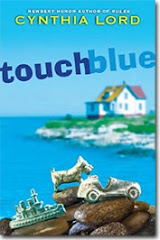Touch Blue went through many revisions. It took me quite awhile to find the story I truly wanted to tell in this book.
One big change the book went through was that when I first wrote Touch Blue, Tess didn't want Aaron to come. She resented that Dad was excited a boy was coming and that her family had to change.
That might be an understandable reaction for Tess, but I kept getting feedback from my critique partners saying they felt so badly for Aaron that they didn't like Tess. I tried giving her bigger reasons why she would feel that way, and I backed up the story so the reader got to know Tess first. But the bottom line was that I had given Aaron a more sympathetic story, which is very hard to overcome. A reader needs to identify with the main character, more than the other characters.
One day I asked myself, "What if Tess wanted Aaron?" It made all the difference.
I don't save many of my drafts, but here was an earlier opening.
Touch blue and your wish will come true.
“The sea likes to keep her secrets,” Dad always says, “but every day she lets a few go.”
At low tide, I find them. They’re never anything ordinary, like a snarl of rope, a broken lobster trap, or a long, frilly ribbon of kelp. Those things wash up in front of our house almost every day—as common as if they belonged between the huge, black-soaked rocks.
No, the sea’s true secrets are always surprises. Yesterday I found an iron teakettle, dotted with barnacles. On Wednesday I uncovered a little wooden jewelry box, empty except for two snails.
Today it’s a round bit of sea glass, just the bottom of a bottle.
"Thank you," I always say, because sometimes you don’t know for sure if something’s important or trash when it first comes.
Looking at this now, I see that it's evocative and a bit symbolic, but it doesn't show the reader what matters most or begin the plot. Here's how the book now begins:
Touch blue and your wish will come true.
“The ferry’s coming!” High on the cliffs, my five-year-old sister, Libby, jumps foot-to-foot. “Come on, Tess! Mom says we can run down to meet it!”
Across the bay the ferry looks small as a toy, leaving the mainland wharf. I’ve seen that boat heading for our island hundreds of times, but never with my heart pounding so hard.
He’s almost here!
When Rules won its Newbery Honor, I made my editor promise that she wouldn't go easier on me because of that award. As you can see from this photo of one of my revision pages, she kept that promise!
And I love her for it.
StorySleuths Tip # 102: Be willing to experiment with character motivation to ensure that reader's can identify with the main character.










